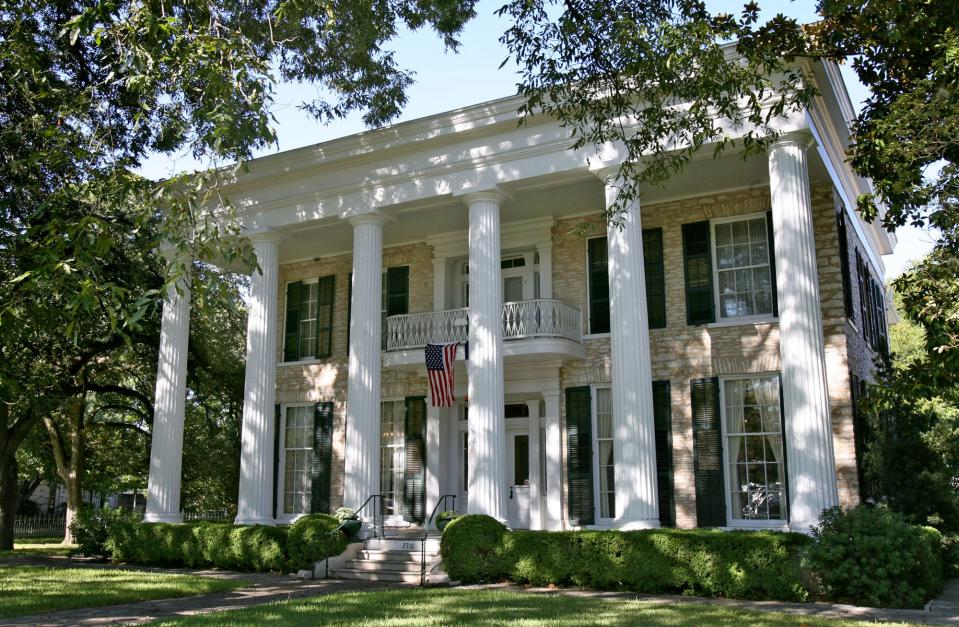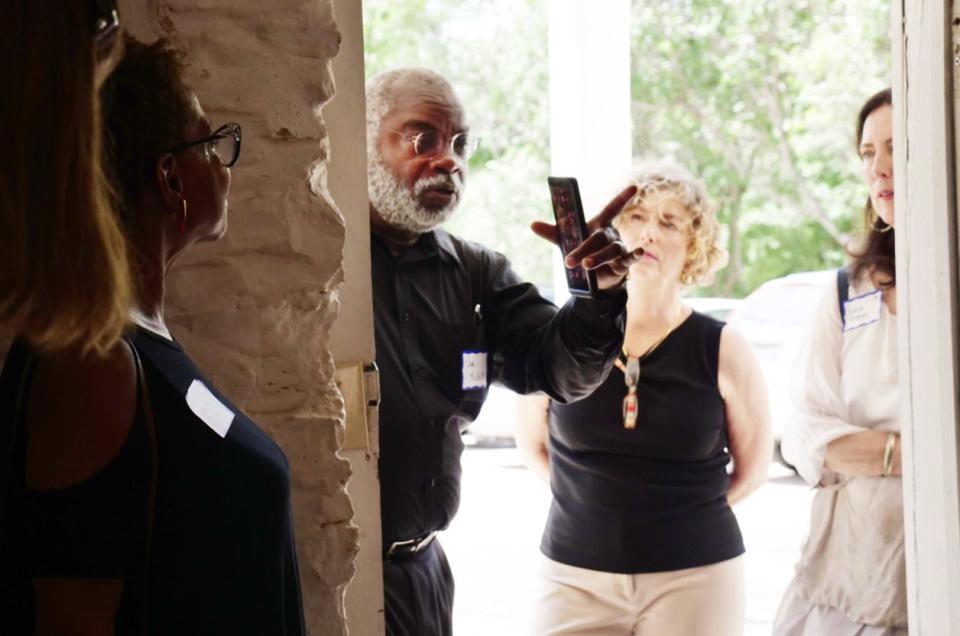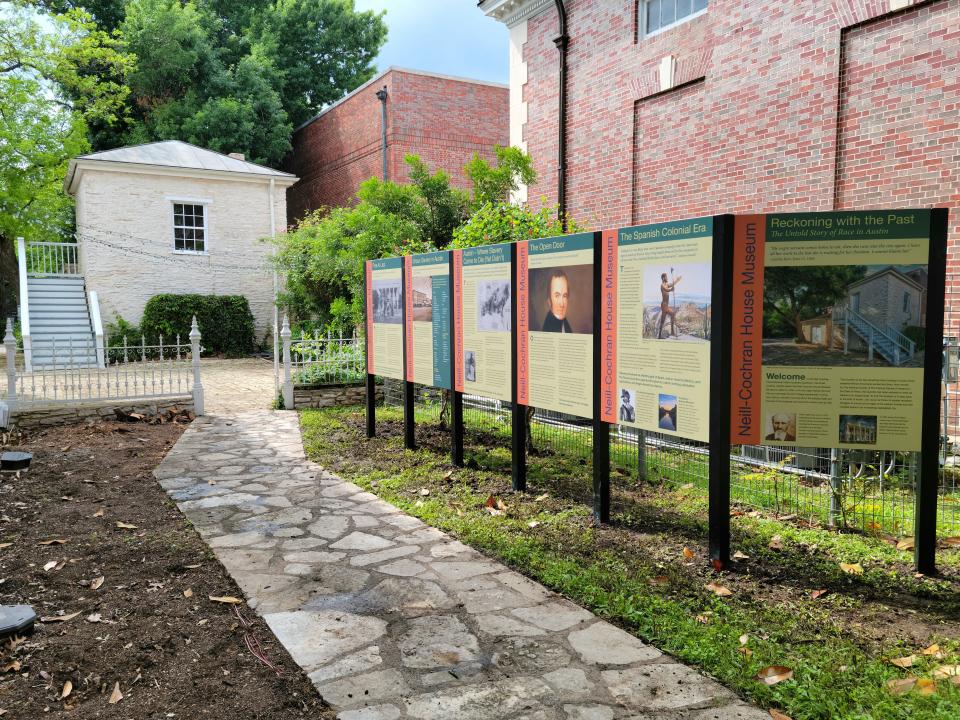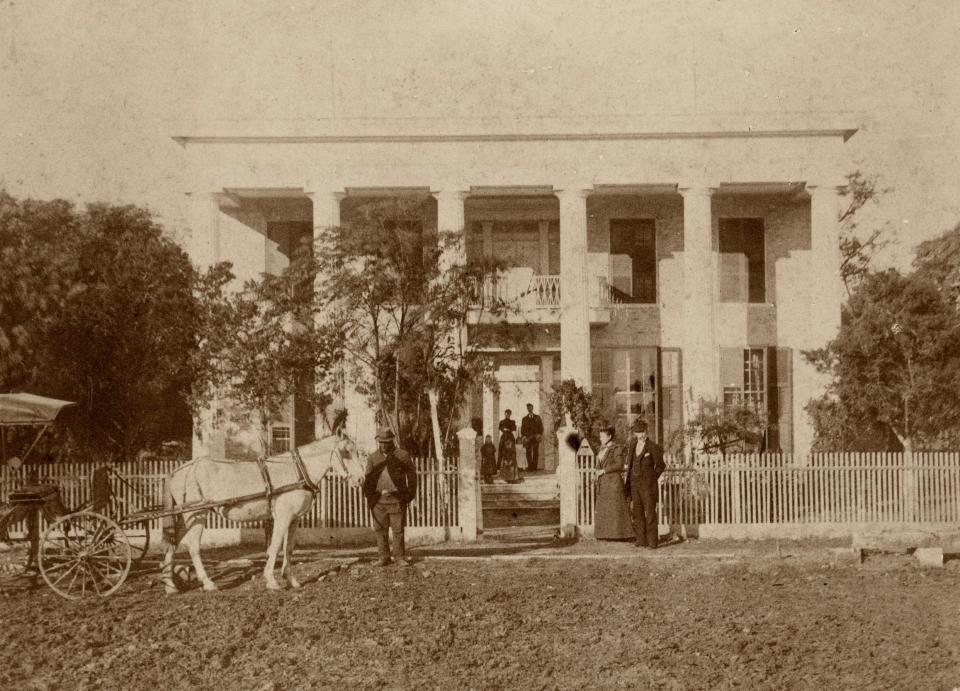'The heart of Austin beats here': Juneteenth, visit city's only intact slave quarters
For more than 150 years, the plain limestone building sat mute behind a grand house guarded by white columns on San Gabriel Street in the West Campus neighborhood.
Two stories high, the back structure revealed few signifiers of its original employment. During the past few years, however, historian after historian has concluded that this building, which might even antedate the nearby antebellum Greek Revival mansion, once housed the enslaved workers who built the Neill-Cochran House, now a museum operated by the National Society of the Colonial Dames of America in the State of Texas.
"I remember the day I realized what the building really was, and what sticks with me is my shock," says Rowena Houghton Dasch, the museum's executive director, about the slave quarters. "Shock that this piece of our history had been hiding in plain sight for decades, and shock that none of us had seen it for what it was. I stood staring down the hall at the back door of the main house, at the realization that all that happened on the other side of that door was made possible by the enslavement economy. "
On June 22, three days after the official Juneteenth holiday, the restored 1856 slave quarters will be reopened with a ceremony that will introduce to the public large interpretive panels that not only tell the story of main house — and the out building — but also the background for the people who lived and worked there.

The Neill-Cochran House's Juneteenth Celebration runs from noon to 5 p.m. Saturday at 2310 San Gabriel St. It includes a lunch, guided tours, songs from a gospel choir and a reception for the exhibit, "Juneteenth Rodeo," related to a new book by Austin author Sarah Bird. Find out more at www.nchmuseum.org.
'An Echo of Belonging': Ebenezer Baptist Church commences 150th year of faith in Austin
Solving an Austin historical mystery
News has trickled out about the Neill-Cochran slave quarters for years. Some skeptics compared the West Campus building to other pre-1865 residences for enslaved people that might be older, while others remarked that there was little oral or written history that confirmed the two-story structure was anything other than a general utility building.
'We didn't let this place die': St. John Colony, Texas, endures for 150 years of grace

Then two things happened. A University of Texas class directed by Tara Dudley, who teaches interior design history and architectural history courses, gathered a small mountain of contextual evidence about work and life patterns of African Americans in Austin before and after emancipation. And then certified interpretive planner Ted Eubanks, who recently did exemplary work on Mount Calvary Catholic Cemetery and Wooldridge Square Park, expanded and refined those findings into a polished survey.
"Historical events and places do not speak for themselves," Eubanks says. "Even when basic historical information is on hand, rarely — especially in Austin — is a fully developed interpretive narrative available. People may learn what happened at a historic location and the people involved, but rarely do they learn the all-important why."
The outdoor interpretive panels at the museum cover the history of African slavery in the Indigenous, Spanish, Mexican and Anglo-American eras, including enslaved Esteban, who reached Texas as a castaway with Spanish explorers 500 years ago.

One of the most interesting panels, however, is titled "Austin: Where Slavery Came to Die, But Didn't." Using a slave density map that I've never seen enlarged so helpfully, this section delves into the geographic limitations to plantation slavery in the more arid lands to the west of the 98th parallel, which runs down the center of Austin.
"If you look closely at the distribution map of slavery in 1860, you will see that distribution halts at Travis County," Eubanks says. "Why? We know that the enslaved were a significant part of the Austin population in its earliest years, but why? Away from the blackland prairie to our east, the Balcones Escarpment did not support a plantation economy. Why were there so many slaves here, who were they, and how did they contribute to the building of early Austin?"
Slavery reached the Austin area even before the city was founded in 1839.
"In 1837, William Barton brought the first enslaved people to the Austin area, although outside of Austin proper," one panel reads. "However, Mahala Murchison, a 10-year-old mulatto girl, came to Austin with her enslavers four months after Austin was founded. While Barton lived outside of what Edwin Waller platted as the new capital city, Murchison lived in the center of the new town."
The panels describe the living conditions for urban slaves as opposed to those who worked on plantations and include a list of the types of jobs they held, some skilled, others not so much.
Although some historians might still quibble with details recorded on the interpretive panels that now lead to the slave quarters, these are the kind of explanatory graphics that Austin has needed for years and in far greater numbers.
The house above the Shoal Creek Canyon
The following narrative is a condensed story of building and using the Neill-Cochran House:
In 1855, master designer and builder Abner Cook, who built the Governor's Mansion among other Austin landmarks, began putting together what was then known as the Washington and Mary Hill House.
Cook designed the home, perched on more than 17 acres on the western edge of Austin. Cook and enslaved craftsmen — both owned and rented — also built the quarters behind the big house.
'And Still We Rise': Exhibit at Galveston's new Juneteenth museum tells powerful history
It turned out that the Hills could not afford the grand home. The Hills sold five of the people they enslaved to help complete the project. Yet before the work was done, the Hills sold the buildings and property to investors Swante Swenson and James Monroe Swisher, whose family owned a farm in South Austin that encompassed part of what is now the Bouldin and Travis Heights neighborhoods. His family's names still mark the streets of those districts.
Under their ownership, the duo leased the property and house to the state of Texas to serve as the Texas State Asylum for the Blind. Asylum students and teachers were the site’s first occupants. According to research by Dudley, these residents included at least six hired-out enslaved people, half of whom were unnamed, who not only completed tasks such as hauling water, but also teaching the students skills such as basket-weaving.

The big house welcomed its first owner-occupants in 1876, the family of Andrew and Jennie Neill. The Neill family moved to Austin that year and lived in the house until 1892.
In 1892, Thomas Cochran rose to a position on the federal bench that brought him, his wife, three young children, and his wife’s parents to Austin. The family first leased and then purchased the site from Jennie Neill in 1895. The Cochran family lived there for 65 years over the course of four generations.
Neither the Neills nor the Cochrans enslaved people on this property, yet freedmen and freedwomen who worked for these families were still unequal citizens of the community. They faced Black Codes, that attempted to control the movement of African Americans; Jim Crow laws, which kept them out of positions of power; and, in the early 20th century, increased segregation in housing, employment, education and basic amenities.
As the interpretive panels make clear, only with the passage of the 1964 Civil Rights Act, the 1965 Voting Rights Act and the 1968 Fair Housing Act, did "freedom begin to become a reality for Black residents."
Without this kind of context — as well as ongoing education and events — the Neill-Cochran House would be, at least to some visitors, just a nicely preserved mansion with beautifully arranged period furniture and decor.
"This is why these interpretive efforts are so critical," Eubanks says. "In a fundamental fashion, these storylines are Austin's roots. Once cut, Austin is untethered, easily swept away in the latest economic and social changes, and easily replaced by other cities that are similarly ephemeral and soulless."
Where can I learn more about Juneteenth in Austin?
Last year, we published a thorough guide, since updated, about the physical sites where you can find out more about Juneteenth and African American history in Austin. Among the top sites: George Washington Carver Museum and Cultural Center, Austin History Center, Texas African American History Memorial, Six Square: Austin's Black Cultural District, African American Cultural and Heritage Facility, Bob Bullock Texas State History Museum and Huston-Tillotson University.
For starters, however, you can't go wrong with the afternoon-long celebration of Juneteenth on June 22 at the Neill-Cochran House. A stroll around its grounds can initiate exchanges on several layers of Austin' history's past.
More: Museum show examines race and who built early Austin
"Tara, Ted and I have come to see the Neill-Cochran House site as a front porch view to the history of Austin," Dasch says. "Behind us along Shoal Creek, Indigenous people passed for thousands of years, and the federal army encamped at the end of the Civil War. Just across the street, the Neills and Cochrans watched the Wheatville colony grow and thrive and, looking straight out to the east, saw the University of Texas creep ever closer.
"The heart of Austin beats here, at one of the few sites left from the city's early period. Who we are today, as a city is predicated on how we got here, and so many of the complexities of that history have intersected with this place. The fact that we steward the only intact and accessible slave dwelling left in Austin is a critical piece of that history."
This article originally appeared on Austin American-Statesman: Layers of Austin history uncovered at West Campus slave quarters

